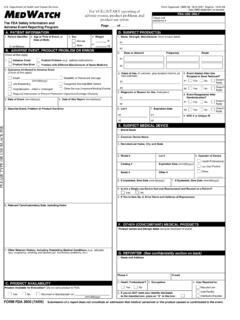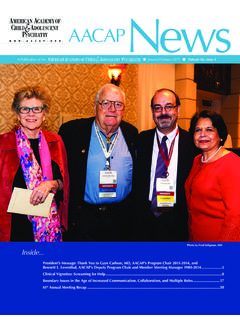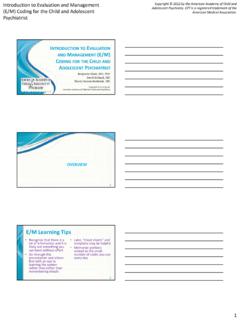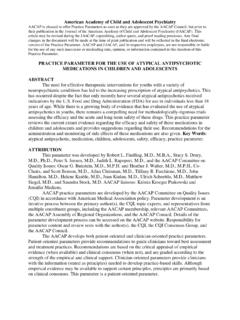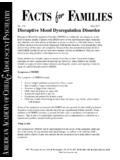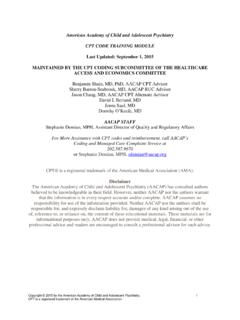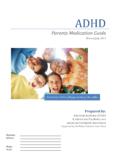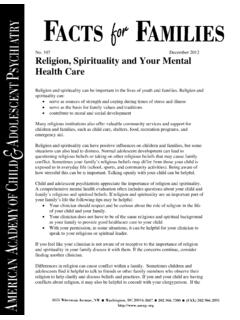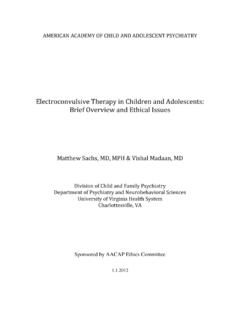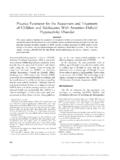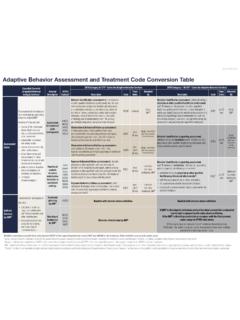Transcription of Practice Parameter for the Assessment and Treatment of ...
1 AACAP OFFICIAL ACTION. Practice Parameter for the Assessment and Treatment of Children and Adolescents With Depressive Disorders ABSTRACT. This Practice Parameter describes the epidemiology, clinical picture, differential diagnosis, course, risk factors, and pharmacological and psychotherapy treatments of children and adolescents with major depressive or dysthymic disorders. Side effects of the antidepressants, particularly the risk of suicidal ideation and behaviors are discussed. Recommen- dations regarding the Assessment and the acute, continuation, and maintenance Treatment of these disorders are based on the existent scientific evidence as well as the current clinical Practice . J. Am. Acad. Child Adolesc. Psychiatry, 2007;. 46(11):1503Y1526. Key Words: major depressive disorder, dysthymic disorder, evaluation, Treatment , antidepressants, selective serotonin reuptake inhibitors, psychotherapy, Practice Parameter .
2 Depressive disorders are often familial recurrent ill- ment may reduce the impact of depression on the family, nesses associated with increased psychosocial morbidity social, and academic functioning in youths and may and mortality. Early identification and effective treat- reduce the risk of suicide, substance abuse, and persis- tence of depressive disorders into adulthood. Evidence- supported Treatment interventions have emerged in Accepted June 7, 2007. psychotherapy and medication Treatment of childhood This Parameter was developed by Boris Birmaher, , and David Brent, , principal authors, and the AACAP Work Group on Quality Issues: depressive disorders that can guide clinicians to improve William Bernet, , Oscar Bukstein, , and Heather Walter, Co-Chairs, outcomes in this population. and R. Scott Benson, , Allan Chrisman, , Tiffany Farchione, , Laurence Greenhill, , John Hamilton, , Helene Keable, , Joan Kinlan, , Ulrich Schoettle, , and Saundra Stock, AACAP Staff: METHODOLOGY.
3 Kristin Kroeger Ptakowski and Jennifer Medicus. The authors acknowledge the following experts for their contributions to this The list of references for this Parameter was devel- Parameter : Jeffrey Bridge, , Amy Cheung, , Greg Clarke, , Graham Emslie, , Philip Hazell, , Stan Kutcher, , Laura oped by searching PsycINFO, Medline, and Psychological Mufson, , Kelly Posner, , Joseph Rey, , Karen Wagner, , Abstracts; by reviewing the bibliographies of book and Elizabeth Weller, chapters and review articles; by asking colleagues for This Parameter was made available for review to the entire AACAP. membership in February and March 2006. suggested source materials; and from the previous From July 2006 to February 2007, this Parameter was reviewed by a version of this Parameter (American Academy of Child Consensus Group convened by the Work Group on Quality Issues. Consensus and Adolescent Psychiatry, 1998), the recent American Group members and their constituent groups were as follows: Work Group on Psychiatric Association/AACAP guidelines BThe Use Quality Issues (Oscar Bukstein, , Helene Keable, , and John Hamilton, ); Topic Experts (Graham Emslie, , and Greg Clarke, of Medication in Treating Childhood and Adolescent ); AACAP Assembly of Regional Organizations (Syed Naqvi, ); and Depression: Information for Physicians[ published AACAP Council (David DeMaso, , and Michael Houston, ).]
4 By , the American Psychiatric Disclosures of potential conflicts of interest for authors and Work Group chairs are provided at the end of the Parameter . Disclosures of potential conflicts of Association guidelines for the Treatment of adults with interest for all other individuals named above are provided on the AACAP Web MDD (American Psychiatric Association, 2000a;. site on the Practice Information page. Fochtmann and Gelenberg, 2005), the Texas algo- This Practice Parameter was approved by the AACAP Council on June 1, 2007. rithms for the Treatment of children and adolescents This Practice Parameter is available on the Internet ( ). with MDD (Hughes et al., 2007), and the National Reprint requests to the AACAP Communications Department, 3615 Institute of Health and Clinical Excellence (NICE;. Wisconsin Avenue, NW, Washington, DC 20016. 2004) guidelines for the Treatment of depressed youths.
5 0890-8567/07/4611-1503 2007 by the American Academy of Child and Adolescent Psychiatry. The searches, conducted in 2005, used the following DOI: text words: Bmajor depressive disorder,[ Bdysthymia,[. J. AM. ACAD. CHILD ADOLESC. PSYCHIATRY, 46:11, NOVEMBER 2007 1503. Copyright @ 2007 American Academy of Child and Adolescent Psychiatry. Unauthorized reproduction of this article is prohibited. AACAP Practice parameters . antidepressants,[ and Bpsychotherapy[ ( , interper- in children and to in adolescents sonal, psychodynamic, cognitive) combined with the (Birmaher et al., 1996). word Bchild.[ The searches covered the period 1990 to Studies in adults and one study in youths have January 2007 and only articles that included depressive suggested that each successive generation since 1940 is disorders were included. Given space limitations, we at greater risk of developing depressive disorders and mainly cited review articles published in refereed that these disorders have their onset at a younger age journals and added new relevant articles not included (Birmaher et al.)]]]]]
6 , 1996). in the reviews. CLINICAL PRESENTATION. DEFINITIONS. Clinical depression manifests as a spectrum disorder The terminology in this Practice Parameter is with symptoms ranging from subsyndromal to syn- consistent with the DSM-IV-TR (American Psychiatric dromal. To be diagnosed with a syndromal disorder Association, 2000b). Unless specified, the term (MDD), a child or adolescent must have at least 2. Bdepression[ encompasses both major depressive dis- weeks of persistent change in mood manifested by order (MDD) and dysthmic disorder (DD). Impair- either depressed or irritable mood and/or loss of interest ment means reduced functioning in one or more major and pleasure plus a group of other symptoms including areas of life (academic performance, family relation- wishing to be dead, suicidal ideation or attempts;. ships, and peer interactions). increased or decreased appetite, weight, or sleep; and The information included in this Parameter pertains decreased activity, concentration, energy, or self-worth mainly to MDD.]
7 There are few clinical studies and no or exaggerated guilt (American Psychiatric Association, controlled trials for the Treatment of DD in youths. 2000b; World Health Organization, 1992). These However, based on the limited adult literature (Ameri- symptoms must represent a change from previous func- can Psychiatric Association, 2000a), efficacious treat- tioning and produce impairment in relationships or in ments for MDD may also be useful for the management performance of activities. Furthermore, symptoms of DD. must not be attributable only to substance abuse, use In this Parameter , unless otherwise specified, the of medications, other psychiatric illness, bereavement, terms Bchild[ and Byouths,[ respectively, refer to chil- or medical illness. dren and adolescents. BParent[ refers to parent or legal Overall, the clinical picture of MDD in children and guardian. adolescents is similar to the clinical picture in adults, but there are some differences that can be attributed EPIDEMIOLOGY.]]]
8 To the child_s physical, emotional, cognitive, and social The prevalence of MDD is estimated to be approx- developmental stages (Birmaher et al., 1996; Fergusson imately 2% in children and 4% to 8% in adolescents, et al., 2005; Kaufman et al., 2001; Klein et al., 2005;. with a male-to-female ratio of 1:1 during childhood Lewinsohn et al., 2003a; Luby et al., 2004; Yorbik and 1:2 during adolescence (Birmaher et al., 1996). The et al., 2004). For example, children may have mood risk of depression increases by a factor of 2 to 4 after lability, irritability, low frustration tolerance, temper puberty, particularly in females (Angold et al., 1998), tantrums, somatic complaints, and/or social withdrawal and the cumulative incidence by age 18 is approximately instead of verbalizing feelings of depression. Also, 20% in community samples (Lewinsohn et al., 1998). children tend to have fewer melancholic symptoms, Approximately 5% to 10% of children and adoles- delusions, and suicide attempts than depressed adults.
9 Cents have subsyndromal symptoms of MDD. These There are different subtypes of MDD, which may youths have considerable psychosocial impairment, have prognostic and Treatment implications. Psychotic high family loading for depression, and an increased depression has been associated with family history of risk of suicide and developing MDD (Fergusson et al., bipolar and psychotic depression (Haley et al., 1988;. 2005; Gonzales-Tejera et al., 2005; Lewinsohn et al., Strober et al., 1993), more severe depression, greater 2000; Pine et al., 1998). The few epidemiological long-term morbidity, resistance to antidepressant mono- studies on DD have reported a prevalence of to therapy, and, most notably, increased risk of bipolar 1504 J. AM. ACAD. CHILD ADOLESC. PSYCHIATRY, 46:11, NOVEMBER 2007. Copyright @ 2007 American Academy of Child and Adolescent Psychiatry. Unauthorized reproduction of this article is prohibited.
10 DEPRESSIVE DISORDERS. disorder (Strober and Carlson, 1982). MDD can be disorder, substance abuse) and medical disorders ( , manifested with atypical symptoms such as increased hypothyroidism, mononucleosis, anemia, certain can- reactivity to rejection, lethargy (leaden paralysis), cers, autoimmune diseases, premenstrual dysphoric increased appetite, craving for carbohydrates, and disorder, chronic fatigue syndrome) as well as condi- hypersomnia (Stewart et al., 1993; Williamson et al., tions such as bereavement and depressive reactions to 2000). Youths with seasonal affective disorder (SAD; stressors (adjustment disorder) may co-occur with or Swedo et al., 1995) mainly have symptoms of depression mimic MDD or DD. These conditions may cause poor during the season with less daylight. SAD should be self-esteem or demoralization, but should not be diag- differentiated from depression triggered by school stress nosed as MDD or DD unless they meet criteria for these because both usually coincide with the school calendar.
